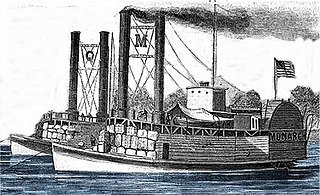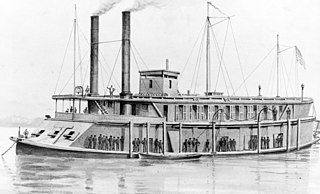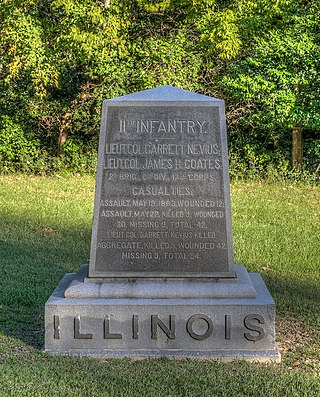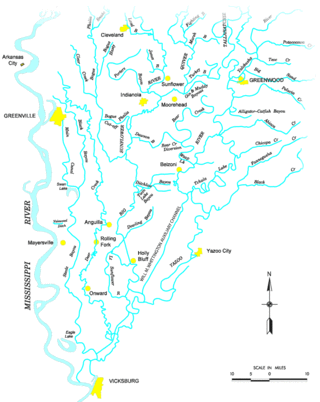
The Vicksburg campaign was a series of maneuvers and battles in the Western Theater of the American Civil War directed against Vicksburg, Mississippi, a fortress city that dominated the last Confederate-controlled section of the Mississippi River. The Union Army of the Tennessee under Major General Ulysses S. Grant gained control of the river by capturing this stronghold and defeating Lieutenant General John C. Pemberton's forces stationed there.

USS Tyler was originally a merchant ship named A. O. Tyler, a commercial side-wheel steamboat with twin stacks and covered paddles positioned aft. Constructed in Cincinnati, Ohio in 1857, it was acquired by the United States Navy, 5 June 1861 for service in the American Civil War and converted into the gunboat USS Tyler on 5 June 1861. She was commissioned in September 1861. She was protected with thick wooden bulwarks.

John Alexander McClernand was an American lawyer, politician, and a Union Army general in the American Civil War. He was a prominent Democratic politician in Illinois and a member of the United States House of Representatives before the war. McClernand was firmly dedicated to the principles of Jacksonian democracy and supported the Compromise of 1850.

The Battle of Milliken's Bend was fought on June 7, 1863, as part of the Vicksburg Campaign during the American Civil War. Major General Ulysses S. Grant of the Union Army had placed the strategic Mississippi River city of Vicksburg, Mississippi, under siege in mid-1863. Confederate leadership erroneously believed that Grant's supply line still ran through Milliken's Bend in Louisiana, and Major General Richard Taylor was tasked with disrupting it to aid the defense of Vicksburg. Taylor sent Brigadier General Henry E. McCulloch with a brigade of Texans to attack Milliken's Bend, which was held by a brigade of newly-recruited African American soldiers. McCulloch's attack struck early on the morning of June 7, and was initially successful in close-quarters fighting. Fire from the Union gunboat USS Choctaw halted the Confederate attack, and McCulloch later withdrew after the arrival of a second gunboat. The attempt to relieve Vicksburg was unsuccessful. One of the first actions in which African American soldiers fought, Milliken's Bend demonstrated the value of African American soldiers as part of the Union Army.
The Meridian campaign or Meridian expedition took place from February 3 – March 6, 1864, from Vicksburg, Mississippi to Meridian, Mississippi, by the Union Army of the Tennessee, led by Maj. Gen. William Tecumseh Sherman. Sherman captured Meridian, Mississippi, inflicting heavy damage to it. The campaign is viewed by historians as a prelude to Sherman's March to the Sea in that a large swath of damage and destruction was inflicted on Central Mississippi as Sherman marched across the state and back.

USS Marmora was a sternwheel steamer that served in the Union Navy from 1862 to 1865, during the American Civil War. Built in 1862 at Monongahela, Pennsylvania, as a civilian vessel, she was purchased for military service on September 17 and converted into a tinclad warship. Commissioned on October 21, the vessel served on the Yazoo River beginning the next month. She encountered Confederate naval mines on the Yazoo on December 11, and was present the next day when the ironclad USS Cairo was sunk by two mines. After further service on the Yazoo during the Battle of Chickasaw Bayou in late December, Marmora was assigned in January 1863 to a fleet that was preparing to operate against Confederate Fort Hindman, but was not present when the fort surrendered on January 11.

The Battle of Snyder's Bluff was fought from April 29 to May 1, 1863, during the Vicksburg Campaign of the American Civil War. Federal Major General Ulysses S. Grant had decided to move most of his army down the west bank of the Mississippi River and then cross south of Vicksburg, Mississippi, at Grand Gulf as part of his campaign against the city. To cover his planned crossing, Major General William T. Sherman took Francis P. Blair Jr.'s division of his XV Corps on a maneuver up the Yazoo River to feint at Confederate defenses at Snyder's Bluff and Drumgould's Bluff.

USS Monarch was a United States Army sidewheel ram that saw service in the American Civil War as part of the United States Ram Fleet and the Mississippi Marine Brigade. She operated on the Mississippi River and Yazoo River during 1862 and 1863.

USS Mound City was a City-class ironclad gunboat built for service on the Mississippi River and its tributaries in the American Civil War. Originally commissioned as part of the Union Army's Western Gunboat Flotilla, she remained in that service until October 1862. Then the flotilla was transferred to the Navy and she became part of the Mississippi River Squadron, where she remained until the end of the war.

USS Signal – a small 190-ton steamship – was acquired during the second year of the American Civil War by the Union Navy and outfitted as a gunboat. She also served other types of duty, such as that of dispatch vessel and convoy escort.

USS Rattler was a steamer acquired by the Union Navy during the American Civil War.

The Pook Turtles, or City-class gunboats to use their semi-official name, were war vessels intended for service on the Mississippi River during the American Civil War. They were also sometimes referred to as "Eads gunboats." The labels are applied to seven vessels of uniform design built from the keel up in Carondelet, Missouri shipyards owned by James Buchanan Eads. Eads was a wealthy St. Louis industrialist who risked his fortune in support of the Union.

The Steele's Bayou expedition was a joint operation of Major General Ulysses S. Grant's Army of the Tennessee and Rear Admiral David D. Porter's Mississippi River Squadron, conducted as a part of the Vicksburg Campaign of the American Civil War. Its aim was to move Union forces from the Mississippi River to a point on the Yazoo River upstream of Confederate Lieutenant General John C. Pemberton's defenses of Vicksburg. To avoid enemy artillery in place on the bluffs to the east of the city, the expedition would leave the Yazoo and proceed indirectly on a route through a series of waterways in the flood plain to the east of the Mississippi.

The Yazoo Pass expedition was a joint operation of Major General Ulysses S. Grant's Army of the Tennessee and Rear Admiral David D. Porter's Mississippi River Squadron in the Vicksburg campaign of the American Civil War. Grant's objective was to get his troops into a flanking position against the Rebel defenders. The expedition was an effort to bypass the Confederate defenses on the bluffs near the city by using the backwaters of the Mississippi Delta as a route from the Mississippi River to the Yazoo River. Once on the Yazoo, the Army would be able to cross the river unopposed and thus achieve their goal. The operation would require a deep penetration into enemy territory that was dominated by water, so cooperation between the two services was necessary. The Army was led by Brigadier General Leonard F. Ross. Naval commander was Lieutenant Commander Watson Smith, whose extremely poor health was an important factor in the ultimate failure of the expedition.
The 11th/17th Consolidated Arkansas Infantry (1861–1865) was a Confederate Army infantry regiment during the American Civil War. The unit is also known as the 11th/17th Arkansas Mounted Infantry or the 11th/17th Arkansas Cavalry. At various times after the consolidation, members of the unit who were captured gave their unit as either the 11th Arkansas Cavalry or the 17th Arkansas Cavalry.

The 11th Regiment Illinois Volunteer Infantry was an infantry regiment from Illinois that served in the Union Army during the American Civil War. In April 1861, it was formed as a three-month volunteer unit, and in July 1861 it was reorganized as a three-year unit, in which role it served until the end of the war. Two of its commanding officers were promoted to brigadier general and led major units during the war. In its first major action at Fort Donelson the regiment suffered terrible losses. The 11th Illinois also fought at Shiloh, Riggins Hill, Vicksburg, First Yazoo City, Second Yazoo City, and Fort Blakely. In April 1863, the 109th Illinois Infantry Regiment was disbanded and its enlisted men transferred into the 11th Illinois. The regiment was mustered out of service in July 1865.

The Yazoo City expedition was an expedition of Union forces from the Vicksburg garrison under General John McArthur against Confederate forces in central Mississippi under General Wirt Adams.

The Battle of Egypt Station was an engagement in Mississippi that took place during a successful Union cavalry raid during the American Civil War. A 3,500-man Union cavalry division under Brigadier General Benjamin Grierson defeated Confederate troops led by Franklin Gardner and Samuel J. Gholson. Grierson's raiding cavalry left Memphis, Tennessee on 21 December and first demolished a Confederate supply depot at Verona. Moving south while wrecking bridges and track along the Mobile and Ohio Railroad, the Union raiders encountered the Confederate defenders at Egypt Station. After their victory, Grierson's cavalry headed southwest to Vicksburg which it reached on January 5, 1865. The raiders destroyed a large amount of Confederate supplies and also damaged the Mississippi Central Railroad. Some of the men captured by Grierson's raiders proved to be former Union soldiers who volunteered to fight for the Confederacy rather than languish in prison camps. When John Bell Hood's army retreated into northern Mississippi after the Battle of Nashville, it was unable to obtain supplies because Grierson's raiders had damaged the railroad so badly.

The 3rd United States Colored Cavalry was a regiment in the United States Army organized as one of the units of the United States Colored Troops during the American Civil War. The regiment was originally formed in October 1863 at Vicksburg, Mississippi as the 1st Mississippi Cavalry Regiment. The unit soon began taking part in expeditions near Vicksburg. In February–March 1864, the regiment saw action at Yazoo City. After being renamed the 3rd U.S. Colored Cavalry in March 1864, the regiment continued to participate in raids, including the Yazoo City expedition in May. In December 1864, the unit took part in a successful raid led by Benjamin Grierson during which the Battle of Egypt Station and other actions were fought. The regiment operated near Memphis, Tennessee, until April 1865, after which it returned to Vicksburg for occupation duties. The soldiers were mustered out of federal service in January 1866.
USS Romeo was a sternwheel steamer that saw service as a tinclad warship during the American Civil War. Completed in August 1862 for civilian trade on the Wabash River, she was instead purchased by the Union Navy for military service in October. Commissioned in December, she cleared naval mines on the Yazoo River later that month before participating in the operations against Confederate-held Fort Hindman in January 1863. After the fall of Fort Hindman, Romeo was part of an expedition up the White River. In February and March 1863, she was part of the Yazoo Pass Expedition, and she fought with Confederates at river landings later in the year to help isolate Vicksburg, Mississippi, during the Vicksburg campaign.


















